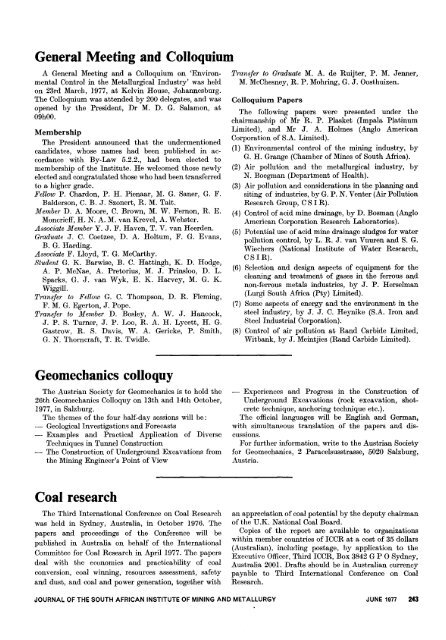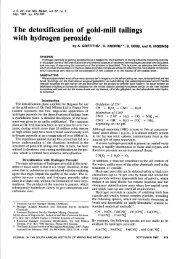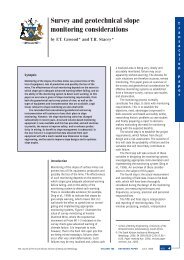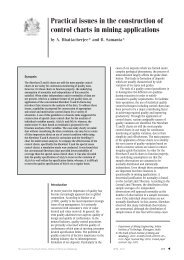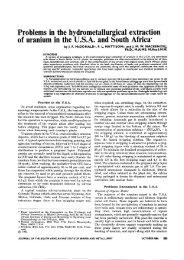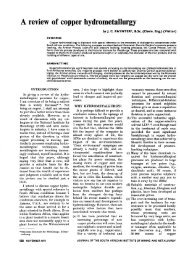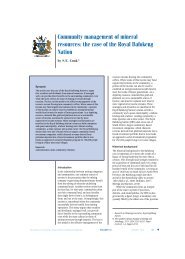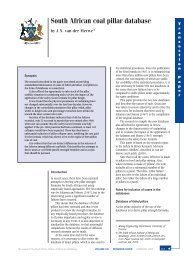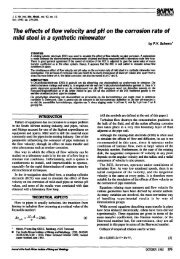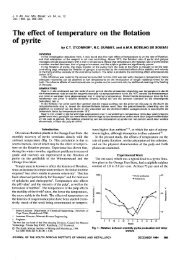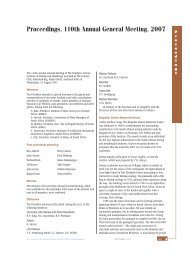General Meeting and Colloquium Coal research - saimm
General Meeting and Colloquium Coal research - saimm
General Meeting and Colloquium Coal research - saimm
Create successful ePaper yourself
Turn your PDF publications into a flip-book with our unique Google optimized e-Paper software.
<strong>General</strong> <strong>Meeting</strong> <strong>and</strong> <strong>Colloquium</strong><br />
A <strong>General</strong> <strong>Meeting</strong> <strong>and</strong> a <strong>Colloquium</strong> on 'Environmental<br />
Control in the Metallurgical Industry' was held<br />
on 23rd March, 1977, at Kelvin House, Johannesburg.<br />
The <strong>Colloquium</strong> was attended by 200 delegates, <strong>and</strong> was<br />
opened by the President, Dr M. D. G. Salamon, at<br />
09hOO.<br />
Membership<br />
The President announced that the undermentioned<br />
c<strong>and</strong>idates, whose names had been published in accordance<br />
with By-Law 5.2.2., had been elected to<br />
membership of the Institute. He welcomed those newly<br />
elected <strong>and</strong> congratulated those who had been transferred<br />
to a higher grade.<br />
Fellow P. Chardon, P. H. Pienaar, M. G. Saner, G. F.<br />
Balderson, C. B. J. Szonert, R. M. Tait.<br />
Member D. A. Moore, C. Brown, M. W. Fernon, R. E.<br />
Moncrieff, H. N. A. M. van Krevel, A. Webster.<br />
Associate Member Y. J. F. Haven, T. V. van Heerden.<br />
Graduate J. C. Coetzee, D. A. Holtum, F. G. Evans,<br />
B. G. Harding.<br />
Associate F. Lloyd, T. G. McCarthy.<br />
Student G. K. Barwise, B. C. Hattingh, K. D. Hodge,<br />
A. P. McNae, A. Pretorius, M. J. Prinsloo, D. L.<br />
Sparks, G. J. van Wyk, E. K. Harvey, M. G. K.<br />
WiggilI.<br />
Transfer to Fellow G. C. Thompson, D. R. Fleming,<br />
F. M. G. Egerton, J. Pope.<br />
Transfer to Member D. Bosley, A. W. J. Hancock,<br />
J. P. S. Turner, J. P. Loo, R. A. H. Lycett, H. G.<br />
Gastrow, R. S. Davis, W. A. Gericke, P. Smith,<br />
G. N. Thorncraft, T. R. Twidle.<br />
Transfer to Graduate M. A. de Ruijter, P. M. Jenner,<br />
M. McChesney, R. P. Mohring, G. J. Oosthuizen.<br />
<strong>Colloquium</strong><br />
Papers<br />
The following papers were presented under the<br />
chairmanship of Mr R. P. Plasket (Impala Platinum<br />
Limited), <strong>and</strong> Mr J. A. Holmes (Anglo American<br />
Corporation of S.A. Limited).<br />
(I) Environmental control of the mining industry, by<br />
G. H. Grange (Chamber of Mines of South Africa).<br />
(2) Air pollution <strong>and</strong> the metallurgical industry, by<br />
N. Boegman (Department of Health).<br />
(3) Air pollution <strong>and</strong> considerations in the planning <strong>and</strong><br />
siting of industries, by G. P. N. Venter (Air Pollution<br />
Research Group, CS I R).<br />
(4) Control of acid mine drainage, by D. Bosman (Anglo<br />
American Corporation Research Laboratories).<br />
(5) Potential use of acid mine drainage sludges for water<br />
pollution control, by L. R. J. van Vuuren <strong>and</strong> S. G.<br />
Wiechers (National Institute of Water Research,<br />
CSIR).<br />
(6) Selection <strong>and</strong> design aspects of equipment for the<br />
cleaning <strong>and</strong> treatment of gases in the ferrous <strong>and</strong><br />
non-ferrous metals industries, by J. P. Herselman<br />
(Lurgi South Africa (Pty) Limited).<br />
(7) Some aspects of energy <strong>and</strong> the environment in the<br />
steel industry, by J. J. C. Heynike (S.A. Iron <strong>and</strong><br />
Steel Industrial Corporation).<br />
(8) Control of air pollution at R<strong>and</strong> Carbide Limited,<br />
Witbank, by J. Meintjies (R<strong>and</strong> Carbide Limited).<br />
Geomechanics<br />
colloquy<br />
The Austrian Society for Geomechanics is to hold the<br />
26th Geomechanics Colloquy on 13th <strong>and</strong> 14th October,<br />
1977, in Salzburg.<br />
The themes of the four half-day sessions will be:<br />
- Geological Investigatiom <strong>and</strong> Forecasts<br />
- Examples <strong>and</strong> Practical Application of Diverse<br />
Techniques in Tunnel Construction<br />
- The Construction of Underground Excavations from<br />
the Mining Engineer's Point of View<br />
- Experiences <strong>and</strong> Progress in the Construction of<br />
Underground Excavations (rock excavation, shotcrete<br />
technique, anchoring technique etc.).<br />
The official languages will be English <strong>and</strong> German,<br />
with simultaneous translation of the papers <strong>and</strong> dis-<br />
ClIssions.<br />
For further information, write to the Austrian Society<br />
for Geomechanics, 2 Paracelsusstrasse, 5020 Salzburg,<br />
Austria.<br />
<strong>Coal</strong> <strong>research</strong><br />
The Third International Conference on <strong>Coal</strong> Research<br />
was held in Sydney, Australia, in October 1976. The<br />
papers <strong>and</strong> proceedings of the Conference will be<br />
published in Australia on behalf of the International<br />
Committee for <strong>Coal</strong> Research in April 1977. The papers<br />
deal with the economics <strong>and</strong> practicability of coal<br />
conversion, coal winning, resources assessment, safety<br />
<strong>and</strong> dust, <strong>and</strong> coal <strong>and</strong> power generation, together with<br />
an appreciation of coal potential by the deputy chairman<br />
of the U.K. National <strong>Coal</strong> Board.<br />
Copies of the report are available to organizations<br />
within member countries of ICCR at a cost of 35 dollars<br />
(Australian), including postage, by application to the<br />
Executive Officer, Third reCR, Box 3842 GPO Sydney,<br />
Austr.alia 2001. Drafts should be in Australian currency<br />
payable to Third International Conference on <strong>Coal</strong><br />
Research.<br />
JOURNAL OF THE SOUTH AFRICAN INSTITUTE OF MINING AND METALLURGY JUNE 1977 243
NIM reports<br />
The following reports are available free of charge from<br />
the National Institute for Metallurgy, Private Bag<br />
X3015, R<strong>and</strong>burg, 2125 South Africa.<br />
Report no. 1836<br />
The analysis of pilot-plnnt products for copper, zinc,<br />
nnd lead with the Telsec Lab-X-~5U AnalY8er. (28th Mar.,<br />
1977).<br />
Suites of sulphide material representative of copper,<br />
zinc, <strong>and</strong> lead concentrates, as well as 'intermediate'<br />
products, low-grade material, <strong>and</strong> tailing samples, were<br />
analysed with the Telsec Lab-X-250 Analyser, which is a<br />
radio-isotope X-ray-fluorescence instrument using<br />
'balanced' filters for energy selection. A brief description<br />
of the instrument is given, stress being laid on the<br />
principle of 'balanced' filters. The determination of<br />
optimum instrumental parameters is described, <strong>and</strong><br />
diagrams are provided to demonstrate the efficacy of<br />
energy selection.<br />
Correlation diagrams are given for all three elements in<br />
each of the materials analysed. The scatter of data<br />
points encountered is examined in terms of possible<br />
spectral interference <strong>and</strong> matrix variation. It was found<br />
that, within specified limits of acceptability (5 per cent<br />
relative for concentrations above 10 per cent, <strong>and</strong> 0,5 per<br />
cent absolute for lower concentrations), all three elements<br />
could be determined satisfactorily in copper <strong>and</strong> lead<br />
concentrates <strong>and</strong> in low-grade material. Zinc concentrates<br />
could be analysed only for zinc.<br />
The mechanisms of the spectral interference effects<br />
peculiar to the use of balanced filters are discussed, <strong>and</strong><br />
a correction procedure is described <strong>and</strong> applied to<br />
improve the correlation for copper in the pres~mce of a<br />
high zinc content. It is shown that the poor correlation<br />
found for 'intermediate' products <strong>and</strong> for lead in zinc<br />
concentrates is mainly due to matrix variations. The<br />
concentration range covered, the sensitivity, the precision,<br />
<strong>and</strong>, where applicable, the detection limits are<br />
tabulated for all three elements <strong>and</strong> all types of material<br />
analysed. A comparison of the results obtained with the<br />
Analyser <strong>and</strong> those obtained by atomic-absorption<br />
spectrophotometry is provided.<br />
Report no. 1839<br />
A valence-bond study (~f dialkalis <strong>and</strong> nlkali hydrides.<br />
(31st Mar., 1977).<br />
An impenetrable-core model is used to derive on':)-<br />
electron wave functions that describe the valence<br />
electrons of alkali atoms. In numerical Heitler-London<br />
calculations, these functions are found to yield<br />
equilibrium internuclear separations that are related<br />
linearly to the observed distances <strong>and</strong> dissociation<br />
energies for the alkali hydrides, which are in line with<br />
the corresponding values for hydrogenic species. The<br />
relation between calculated <strong>and</strong> observed dissociation<br />
energies of dialkalis is obscure <strong>and</strong> suggests revision of<br />
the accepted experimental values.<br />
Report no. 1873<br />
The rapid reduction of gamma-ray spectra with a desk-top<br />
calculator. (31st Mar., 1977).<br />
A programme has been written for a desk-top programmable<br />
calculawr, so that gamma-ray spectra can be<br />
processed immediately after the counting of active<br />
samples. The programme has some unusual features,<br />
among them automatic boundary selection <strong>and</strong> rejection<br />
of insignificant peaks. Operation is quick <strong>and</strong> simple, <strong>and</strong><br />
the results agree well with those obtained from an I.B.M.<br />
computer, Model 370/158.<br />
Report no. 1880<br />
The electrochemical reduction of silver chloride <strong>and</strong> its<br />
application to the refining of silver. (llth Mar., 1977).<br />
The direct electrochemical reduction of electrodes cast<br />
from molten silver chloride, <strong>and</strong> the electrorefining of the<br />
resulting metal, have been investigated. Application to<br />
the refining of silver from a local gold refinery has been<br />
considered, <strong>and</strong> preliminary tests have been carried out<br />
on crude material produced at the refinery. The advantages<br />
<strong>and</strong> limitations of the method are discussed,<br />
<strong>and</strong> a comparison with the existing process is made.<br />
Report no. 1886<br />
A rapid method for the determination of fluoride in<br />
geological samples. (31st Mar., 1977).<br />
An account is given of a rapid procedure for the<br />
determination, by use of the specific-ion electrode, of<br />
fluoride in geological samples.<br />
The sample is fused with sodium hydroxide in a nickel<br />
crucible in a muffle furnace. The melt is leached with<br />
water, a buffer of ammonium citrate is added, <strong>and</strong> the<br />
fluoride activity is measured with a specific-ion electrode.<br />
All operations are carried out in the crucible, making<br />
possible approximately 100 determinations a day. The<br />
precision ofthe method is approximately 10 per cent at a<br />
fluoride concentration of 500 p.p.m., which is acceptable<br />
for geological-survey work.<br />
Report no. 1895<br />
A review of applications of plasma technology with<br />
particular reference to ferro-alloy prod11ction. (14th Apr.,<br />
1977).<br />
The present st:\te of the technology relating to plasma<br />
generation <strong>and</strong> plasma furnaces is described, with<br />
particular reference to extractive metallurgy <strong>and</strong> refining<br />
techniques. A brief survey is presented of typical<br />
applications of plasma technology in metallurgical<br />
processing, <strong>and</strong> the work carried out on ferro-alloy<br />
applications is discussed in detail.<br />
The feasibility of the falling-film plasma furnace for<br />
the reduction of iron oxide <strong>and</strong> vanadium oxide has<br />
already been demonstrated by the Bethlehem Steel<br />
Corporation. In this report, a preliminary evaluation is<br />
made of the use of plasma furnaces for the reduction of<br />
Transvaal chromite.<br />
244 JUNE 1977 JOURNAL OF THE SOUTH AFRICAN INSTITUTE OF MINING AND METALLURGY
Geophysics <strong>and</strong> geochemistry<br />
Exploration 77, an international symposium on geophysics<br />
<strong>and</strong> geochemistry applied to the search for<br />
metallic ores, is to be held in Ottawa from 16th to 20th<br />
October, 1977. The symposium, which is being sponsored<br />
by the Canadian Geoscience Council, is a sequel to the<br />
Canadian Centennial Conference on Mining Geophysics<br />
held at Niagara Falls in 1967, <strong>and</strong> will provide a review,<br />
by internationally known authorities, of techniques<br />
used in the exploration for metallic minerals.<br />
The following topics are to be included:<br />
Airborne EM Methods; Ground EM Methods; Electric<br />
Potential Methods; Other Potential Field Methods;<br />
Induced Polarization; Nuclear Geophysics; Induced<br />
Nuclear Geophysics; Borehole Logging Techniques;<br />
Soil <strong>and</strong> Overburden Geochemistry; Lithogeochemistry;<br />
Particulate <strong>and</strong> Gaseous Geochemistry; Special Analytical<br />
Methods; Biogeochemistry; Stream Sediment<br />
Geochemistry; Lake Sediment Geochemistry; Hydrogeochemistry;<br />
Remote Sensing Techniques; Computer<br />
Compilation <strong>and</strong> Interpretations; Integrated Exploration<br />
Programmes; A series of Examples from Diverse<br />
Environments, Mainly Tropical <strong>and</strong> Temperate Areas of<br />
the World.<br />
Further details are available from Exploration 77,<br />
Rm 567, Geological Survey of Canada, 601 Booth Street,<br />
Ottawa, Canada KIA OE8.<br />
Jet cutting<br />
The series of bi-annual international symposia on jet<br />
cutting that BHRA introduced in April 1972 has seen<br />
the venue move from Coventry to Cambridge in the<br />
U.K. <strong>and</strong> then to Chicago in the U.S.A. The Fourth<br />
Symposium will be held at the University of Kent at<br />
Canterbury, Engl<strong>and</strong>, from April 12th to 14th, 1978,<br />
<strong>and</strong> will again be organized by BHRA Fluid Engineering.<br />
Rising costs of materials are forcing manufacturing<br />
companies throughout industry to re-examine their<br />
production techniques. New <strong>and</strong> sophisticated cutting<br />
<strong>and</strong> profiling techniques are significant among the many<br />
new processes being studied <strong>and</strong> developed, <strong>and</strong> this<br />
meeting will provide a further occasion for the advances<br />
in jet cutting technology to be presented <strong>and</strong> discussed.<br />
It is appreciated that the emphasis in the subject<br />
matter of these conferences has swung from the initial<br />
theoretical <strong>and</strong> laboratory studies of the practicality of<br />
jet techniques to the preparation <strong>and</strong> testing of prototype<br />
systems in field applications. By the time of the fourth<br />
meeting, it is expected that equipment described at the<br />
third symposium will have been tested under industrial<br />
conditions.<br />
The topics of the Symposium are as follows:<br />
Fluid mechanics of jets<br />
- Applications of high-pressure cutting operations in<br />
industry <strong>and</strong> civil engineering, <strong>and</strong> in mining <strong>and</strong><br />
tunnelling<br />
- Design <strong>and</strong> operation of jet cutting equipment<br />
- Jet cleaning<br />
- Safety measures<br />
- Economics.<br />
Enquiries should be addressed to: Organizing<br />
Secretary, 4th ISJCT, BHRA Fluid Engineering,<br />
Cranfield, Bedford, MK43 OA,J, Engl<strong>and</strong>.<br />
World mining congress<br />
The Tenth World Mining Congress will be held in<br />
Istanbul, Turkey, in October 1979, with the following<br />
programme:<br />
6th to 13th October, 1979-Exhibition of mining<br />
machinery<br />
8th to 12th October, 1979-Congress<br />
13th to 19th October, 1979-Study tours.<br />
The Turkish National Committee has proposed to the<br />
International Organizing Committee that the Congress<br />
should deal with the following subjects under the general<br />
theme 'Mining <strong>and</strong> mineral raw materials in the service<br />
of mankind' :<br />
1. Utilization for energy purposes of low calorific<br />
materials such as lignite, bituminous shale,<br />
asphaltite.<br />
2. Mining problems related to small ore deposits of<br />
chromite, boron, manganese, lead-zinc, etc. <strong>and</strong> their<br />
utilization.<br />
3. Mining of deposits under difficult geological conditions<br />
(off-shore deposits, marine deposits, deposits<br />
under high pressure).<br />
4. Feasibility <strong>and</strong> profitability studies related to the<br />
economics of mineral deposits.<br />
5. Round-table discussions.<br />
The proposal is preliminary <strong>and</strong> will be finalized in due<br />
course. Members of the Institute are being informed now<br />
since it is desirable, not only that as many South Africans<br />
as possible should participate in the Congress, but also<br />
that as many papers as possible from South Africa<br />
should be presented. It is hoped that this early warning<br />
will help to solicit papers. Enquiries should be directed to<br />
Dr H. G. Denkhaus, CS I R, P.O. Box 395, 0001<br />
Pretoria. Telephone (012)-749111, ext. 2127.<br />
JOURNAL OF THE SOUTH AFRICAN INSTITUTE OF MINING AND METALLURGY JUNE 1977 245
GUIDE TO THE PREPARATION OF PAPERS FOR PUBLICATION IN THE JOURNAL<br />
OF THE SOUTH AFRICAN INSTITUTE OF MINING AND METALLURGY<br />
The following notes have been compiled<br />
to assist authors in the preparation of<br />
papers for presentation to the Institute<br />
<strong>and</strong> for publication in the Journal. All<br />
papers must meet the st<strong>and</strong>ards set by the<br />
Council of the Institute, <strong>and</strong> for this purpose<br />
all papers are referred to at least two<br />
referees appointed by the Council.<br />
Although the worldwide readership of<br />
the Journal results in a preference for<br />
papers in English, the Council treats<br />
papers in Afrikaans on an equal basis, but,<br />
to meet the needs of the majority of<br />
readers, an English summary of some 500<br />
to 750 words should be provided.<br />
STANDARDS FOR ACCEPTANCE<br />
To merit consideration, papers should<br />
conform to the high st<strong>and</strong>ards that have<br />
been established for publication over many<br />
years. Papers on <strong>research</strong> should contain<br />
matter that is new, interpretations that<br />
are novel or of new significance, <strong>and</strong> conclusions<br />
that cast a fresh light on old ideas.<br />
Descriptive papers should not be a repetition<br />
of well-known practices or ideas but<br />
should incorporate developments that<br />
would be of real interest to technical men<br />
<strong>and</strong> of benefit to the mining <strong>and</strong> metallurgical<br />
industry.<br />
In some cases, a well-prepared review<br />
paper can be of value <strong>and</strong> will be considered<br />
for publication. All papers, particularly<br />
<strong>research</strong> papers, no matter how<br />
technical the subject, should be written<br />
with the average reader of the Journal in<br />
mind, to ensure wide interest.<br />
The amount of textbook material included<br />
in a contribution should be the<br />
minimum essential to the argument. The<br />
length of a paper is not the criterion of its<br />
worth, <strong>and</strong> it should be as brief <strong>and</strong> concise<br />
as possible consistent with the lucid<br />
presentation of the subject. Only in very<br />
exceptional circumstances should a paper<br />
exceed 15 pages of the Journal (15000<br />
words if there are no tables or diagrams).<br />
Six to ten pages is more normal.<br />
NOTE: Papers in the Journal are printed<br />
in 10 point type, which is larger than the<br />
8 point type used on this page. For special<br />
publications, Council may decide on page<br />
sizes smaller than A4 used for this Journal.<br />
The text should be typewritten, doublespaced,<br />
on one side only on A4 size paper,<br />
leaving a left-h<strong>and</strong> margin of 4 cm, <strong>and</strong><br />
should be submitted in triplicate to facilitate<br />
the work of the referees <strong>and</strong> editors.<br />
LAYOUT AND STYLE<br />
Orthodox sequence<br />
Title <strong>and</strong> author's name, with author's<br />
degrees, titles, position.<br />
Synopsis, including a brief statement of<br />
conclusions.<br />
An Afrikaans translation of the synopsis.<br />
Introduction.<br />
Development of the main substance.<br />
Conclusions, in more detail.<br />
Acknowledgements.<br />
References.<br />
Title: This should be as brief as possible,<br />
yet give a good idea of the subject <strong>and</strong><br />
character of the paper.<br />
Style; Writing should conform to certain<br />
prescribed st<strong>and</strong>ards.<br />
The Institute is guided in its requirements<br />
by:<br />
Conins, F. H. Authors & Printers'<br />
Dictionary-Oxford University Press.<br />
Hart, H. Rules for Compositors <strong>and</strong><br />
Readers-Humphrey Milford (familiarly<br />
known as the Oxford Rules).<br />
Fowler, H. W. & F. G. The King's<br />
English---Oxford University Press.<br />
<strong>General</strong>: A few well-selected diagrams<br />
<strong>and</strong> illustrations are often more pertinent<br />
than an amorphous mass of text. Overstatement<br />
<strong>and</strong> dogmatism are jarring <strong>and</strong><br />
have no place in technical writing. Avoid<br />
the use of the first person, be objective,<br />
<strong>and</strong> do not include irrelevant or extraneous<br />
matter. Avoid unnecessary use<br />
of capitals <strong>and</strong> hyphens; punctuation<br />
should be used sparingly <strong>and</strong> be governed<br />
by the needs of sense <strong>and</strong> diction. Sentences<br />
should be short, uninvolved, <strong>and</strong><br />
unambiguous. Paragraphs should also be<br />
short <strong>and</strong> serve to separate basic ideas into<br />
compact groups. Quotation marks should<br />
be of the 'single' type for quotations <strong>and</strong><br />
"double" for quoted matter within quotations.<br />
Interpretations in the text should be<br />
marked off by parentheses ( ), whereas<br />
brackets [ ] are employed to enclose<br />
explanatory matter in the text.<br />
Words to be printed in italics should be<br />
underlined singly. For small capitals they<br />
are to be underlined DOUBLY <strong>and</strong> for large<br />
capitals TREBLY.<br />
If there is any problem in producing<br />
formulae accurately by typewriter, they<br />
should be h<strong>and</strong>written in ink.<br />
Abbreviations <strong>and</strong> symbols are laid<br />
down in British St<strong>and</strong>ard 1991. Abbreviations<br />
are the same for the singular<br />
<strong>and</strong> plural, e.g., cm for centimetre <strong>and</strong><br />
centimetres, kg for kilogram <strong>and</strong> kilograms.<br />
Percentages are written in the text<br />
as per cent; the symbol % is restricted to<br />
tables. A full stop after an abbreviation is<br />
used only if there is likely to be confusion<br />
of meaning.<br />
Metric System: The Systeme International<br />
d'Unites (SI) is to be used for<br />
expressing quantities. This is a coherent<br />
system of metric units derived from six<br />
basic units (metre, kilogram, second,<br />
ampere, kelvin, <strong>and</strong> c<strong>and</strong>ela), from which<br />
are derived all other units, e.g., the unit<br />
of force is the newton (N) for kilogram<br />
metre per square second (kg m/s2). Always<br />
use the st<strong>and</strong>ard metric abbreviations.<br />
The comma must be used as a decimal<br />
indicator <strong>and</strong> must not be used for separating<br />
groups of digits. For ease of reading,<br />
digits should be grouped in threes counting<br />
from the decimal indicator towards<br />
the left <strong>and</strong> right. However, where there<br />
are only four digits to the left to right of'<br />
the decimal indicator, there should be no<br />
grouping.<br />
Illustrations: Drawings <strong>and</strong> diagrams<br />
are to be in black India ink <strong>and</strong> should be<br />
about 18 cm wide. When submitting graphical<br />
representations, avoid a fine grid<br />
if possible. Curves should be in heavy line<br />
to st<strong>and</strong> out. Lettering too should be bold,<br />
as a reduction in size is often involved in<br />
the printing process.<br />
Numbering of tables should be in<br />
Roman numerals: I, 11, etc., <strong>and</strong> figures<br />
in Arabic numerals: Fig.<br />
(Always use the abbreviation<br />
I, Fig. 2, etc.<br />
for figure.)<br />
Photographs should be black <strong>and</strong> white<br />
glossy prints.<br />
As a guide to the printer, the author<br />
should indicate by means of notes in the<br />
typescript where tables <strong>and</strong> figures, etc.<br />
are to appear in the text.<br />
Paragraphs: A decimal system of<br />
numbering paragraphs may be used when<br />
the paper is long <strong>and</strong> complicated <strong>and</strong><br />
there is a need for frequent reference to<br />
other parts of the paper.<br />
Proof correction: Galley proofs are sent<br />
to authors for the correction of printers'<br />
errors <strong>and</strong> not for the purpose of making<br />
alterations <strong>and</strong> additions, which may be<br />
expensive. Should an author make alterations<br />
that are considered excessive,<br />
he may be required to pay for them.<br />
St<strong>and</strong>ard symbols as laid down in British<br />
St<strong>and</strong>ard 1219C should be used.<br />
SYNOPSIS<br />
It is most important that the synopsis<br />
should provide a clear outline of the contents<br />
of the paper, the results obtained,<br />
<strong>and</strong> the author's conclusions. It should be<br />
written concisely <strong>and</strong> in normal, rather<br />
than abbreviated, English, <strong>and</strong> should not<br />
exceed 250 words, except when an English<br />
summary of an Afrikaans paper is involved.<br />
While the emphasis is on brevity,<br />
this should not be laboured to the extent<br />
of leaving out important matter<br />
pairing intelligibility. Summaries<br />
or im-<br />
simplify<br />
the task of abstractors <strong>and</strong> therefore<br />
should<br />
picture.<br />
present a balanced <strong>and</strong><br />
It is preferable to use<br />
complete<br />
st<strong>and</strong>ard<br />
rather than proprietary terms.<br />
FOOTNOTES AND REFERENCES<br />
Footnotes should be used only when<br />
they are indispensible. In the typescript<br />
they should appear immediately below<br />
the line to which they refer <strong>and</strong> not at<br />
the foot of the page.<br />
References should be indicated by<br />
super-script, thus. . .1 . . .2. Do not use<br />
the word Bibliography. When authors<br />
cite publications of other societies or<br />
technical <strong>and</strong> trade journals, titles should<br />
be abbreviated in accordance with the<br />
st<strong>and</strong>ards adopted in this Journal.<br />
GENERAL<br />
The Council will consider the publication<br />
of technical notes taking up to<br />
three pages (maximum 3000 words).<br />
Written contributions are invited to the<br />
discussion of all papers published in the<br />
Journal. The editors, however, are empowered<br />
by the Council to edit all contributions.<br />
Once a paper or a note has<br />
been submitted to the Institute, that<br />
document becomes the property of the<br />
Institute, which then holds the copyright<br />
when it is published. The Institute as a<br />
body is, however, not responsible for the<br />
statements made or opinions expressed in<br />
any of its publications. Reproduction<br />
from the Journal is permitted provided<br />
there is full acknowledgement of the<br />
source. These points should be borne in<br />
mind by authors who submit their work<br />
to other organizations as well as to the<br />
Institute.<br />
246 JUNE 1977<br />
JOURNAL OF THE SOUTH AFRICAN INSTITUTE OF MINING AND METALLURGY


